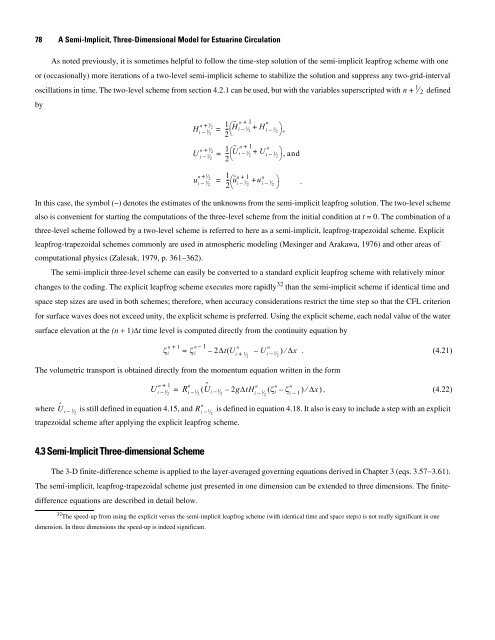A Semi-Implicit, Three-Dimensional Model for Estuarine ... - USGS
A Semi-Implicit, Three-Dimensional Model for Estuarine ... - USGS
A Semi-Implicit, Three-Dimensional Model for Estuarine ... - USGS
You also want an ePaper? Increase the reach of your titles
YUMPU automatically turns print PDFs into web optimized ePapers that Google loves.
78 A <strong>Semi</strong>-<strong>Implicit</strong>, <strong>Three</strong>-<strong>Dimensional</strong> <strong>Model</strong> <strong>for</strong> <strong>Estuarine</strong> Circulation<br />
As noted previously, it is sometimes helpful to follow the time-step solution of the semi-implicit leapfrog scheme with one<br />
or (occasionally) more iterations of a two-level semi-implicit scheme to stabilize the solution and suppress any two-grid-interval<br />
oscillations in time. The two-level scheme from section 4.2.1 can be used, but with the variables superscripted with n<br />
by<br />
+ ⁄ 1<br />
-- H<br />
2<br />
˜ n + 1 n<br />
i – 1 = ⎛ ⁄ + H 2 i – 1 ⎞<br />
⁄ 2 ,<br />
⎝ ⎠<br />
n 1<br />
2 Hi – 1⁄ 2<br />
n<br />
+ ⁄ 1 + 1 n<br />
-- Ũ i – 1 = ⎛ ⁄ + U 2 i – 1 ⎞<br />
⁄ 2 , and<br />
2⎝<br />
⎠<br />
n 1<br />
2 U i – 1⁄ 2<br />
+ ⁄ 1 n -- + 1 n<br />
= ⎛ũi– 1<br />
2 2 ⁄ + u i – 1 ⎞<br />
⁄ 2 .<br />
⎝ ⎠<br />
n 1<br />
2 ui – 1⁄ 2<br />
1<br />
+ ⁄ 2 defined<br />
In this case, the symbol (~) denotes the estimates of the unknowns from the semi-implicit leapfrog solution. The two-level scheme<br />
also is convenient <strong>for</strong> starting the computations of the three-level scheme from the initial condition at t = 0. The combination of a<br />
three-level scheme followed by a two-level scheme is referred to here as a semi-implicit, leapfrog-trapezoidal scheme. Explicit<br />
leapfrog-trapezoidal schemes commonly are used in atmospheric modeling (Mesinger and Arakawa, 1976) and other areas of<br />
computational physics (Zalesak, 1979, p. 361−362).<br />
The semi-implicit three-level scheme can easily be converted to a standard explicit leapfrog scheme with relatively minor<br />
changes to the coding. The explicit leapfrog scheme executes more rapidly 32 than the semi-implicit scheme if identical time and<br />
space step sizes are used in both schemes; there<strong>for</strong>e, when accuracy considerations restrict the time step so that the CFL criterion<br />
<strong>for</strong> surface waves does not exceed unity, the explicit scheme is preferred. Using the explicit scheme, each nodal value of the water<br />
surface elevation at the (n + 1)Δt time level is computed directly from the continuity equation by<br />
n + 1<br />
ζi n – 1<br />
n<br />
n<br />
= ζ i – ( + – U<br />
⁄ i – 1⁄ ) ⁄ Δx.<br />
(4.21)<br />
2<br />
2Δt U i 1 2<br />
The volumetric transport is obtained directly from the momentum equation written in the <strong>for</strong>m<br />
+<br />
n 1<br />
U i – 1⁄ 2<br />
n<br />
Ri – 1⁄ Û 2 i 1⁄ 2<br />
n<br />
where Û i – 1⁄ is still defined in equation 4.15, and R 2<br />
i – 1⁄ 2<br />
trapezoidal scheme after applying the explicit leapfrog scheme.<br />
4.3 <strong>Semi</strong>-<strong>Implicit</strong> <strong>Three</strong>-dimensional Scheme<br />
n n n<br />
= ( – – 2gΔtHi – 1⁄ ( ζi – ζ<br />
2 i – 1)<br />
⁄ Δx)<br />
, (4.22)<br />
is defined in equation 4.18. It also is easy to include a step with an explicit<br />
The 3-D finite-difference scheme is applied to the layer-averaged governing equations derived in Chapter 3 (eqs. 3.57−3.61).<br />
The semi-implicit, leapfrog-trapezoidal scheme just presented in one dimension can be extended to three dimensions. The finite-<br />
difference equations are described in detail below.<br />
32 The speed-up from using the explicit versus the semi-implicit leapfrog scheme (with identical time and space steps) is not really significant in one<br />
dimension. In three dimensions the speed-up is indeed significant.

















